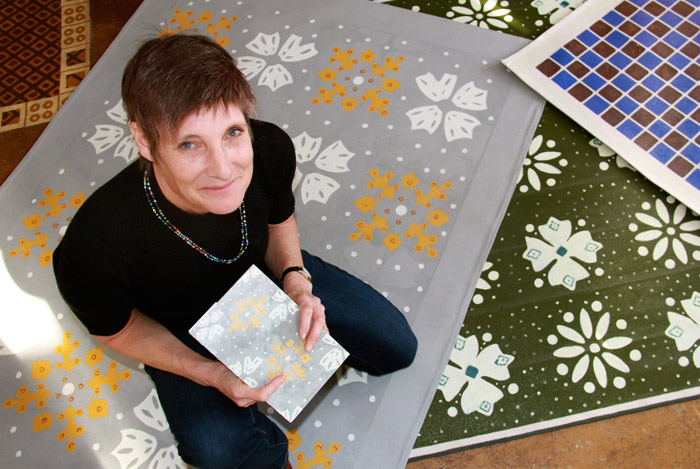Village News
Resurfacing: Mennonite Floor Patterns – Part 2

Recently, guests gathered in the Gerhard Ens Gallery at Mennonite Heritage Village (MHV) to open “Resurfacing: Mennonite Floor Patterns,” an exhibit by Margruite Krahn. Krahn is an artist based in Neubergthal and “Resurfacing” highlights twenty years of her research and artistic expression re-creating historical Mennonite floor patterns.
Inside the gallery, visitors can see fifteen of Krahn’s original works of art that re-imagine and re-create historical Mennonite floor patterns found in old housebarns, mostly located in the former Mennonite West Reserve (around the Winkler, Morden area). Alongside the floor cloths, the exhibit includes a unique collage of photos taken of thirty-six historical patterns found by Krahn and Roland Sawatzky, Curator of History at the Manitoba Museum, during his PhD research on Mennonite housebarns. Despite the age and layers of paint shown on the floors in the photos, visitors with a keen eye will be able to find many of their historical patterns in Krahn’s artwork throughout the exhibit.
Rounding out the exhibit are artefacts, like a trap door from about 1910, found in the Klippenstein housebarn in Neubergthal, and a section of original floor boards from about 1912, found in the Herdsman’s House, also in the Neubergthal. The artefacts highlight the original floor patterns found in both buildings and feature both floral and geometric patterns. The trap door is particularly unique in that it demonstrates how floors were repeatedly re-painted with new patterns. It features numerous levels of paint and three different patterns, each painted over the last one.
At the opening, Krahn remarked that Mennonite floor patterns help to dispel the idea that Mennonites from the past were drab, austere people with no eye for beauty or need for creativity. Indeed, visitors walking into the gallery were struck by the vibrant colours and bold designs of the patterns on display. Krahn used her floor cloths to challenge the crowd at the opening to think about history differently and to question whether our commonly held ideas about history are actually true. Her comment brought to mind a sign I saw in Steinbach last year with this word of caution: “don’t believe everything you think.” I invite you to visit MHV to take in “Resurfacing,” on display now until April 1, and re-consider what you thought you knew about history.




